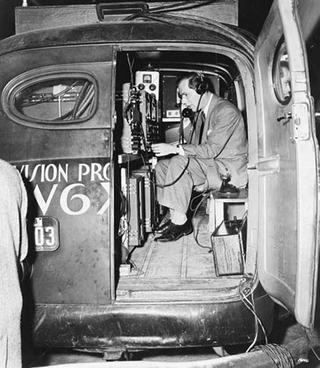Remembering the Early Days of L.A. Television

ALEXANDRIA, VA.— For most of us, it’s difficult to imagine a world devoid of television, or for that matter, a world where there were only one or two channel choices and television service was limited to just a few hours per day. However, even in large cities, this is the way it once was.
Veteran television producer and director Joel Tator has now assembled a 167- page book that begins with a look at what Los Angeles television was like in its infancy in the early 1930s and tracking its evolution and changes over time.
“Los Angeles Television” is basically a picture book—an assemblage of historical photographs and reproductions of related items (newspaper ads, show tickets, station schedules and the like) with fairly lengthy and well-researched captions offering information about these photos and providing linkage to their place in the overall Los Angeles television history. This approach makes otherwise unpublished and inaccessible photographs available and, in this case, provides a good amount of factual information (not always the case in similar pictorial histories I’ve examined). Also, there are introductions for each of its four chapters that help set the stage for what’s about to be presented and put it in perspective. As such, while not a fully comprehensive and detailed history, “Los Angeles Television” goes way beyond being just some nice “eye candy.”

Klaus Landsberg played a large role in establishing television in Los Angeles. His credentials included the 1936 Berlin Olympics and RCA’s 1939 N.Y. World’s Fair TV demo. He’s seen here in an early remote truck he built for Paramount Pictures’ W6XAO.
HOW IT ALL STARTED
Tator begins his eight-decade tour of television in the City of the Angels with the hiring of young engineer Harry Lubcke, by Don Lee, an early distributor of expensive automobiles, who also had a keen interest in broadcasting. It was Lee’s intent to add a television station alongside his KHJ radio operation and Lubcke obliged, putting Los Angeles’s first electronic TV station, W6XAO, on the air in late 1931. It operated for one hour per day and reached all five of the known “television homes” in greater Los Angeles. (After a lot of twists and turns, it’s now known as KCBS-TV.)
Tator also does a very credible job of tracking the history of L.A. station number two, W6XYZ (now KTLA).
KLAUS LANDSBERG REMEMBERED
Of special interest to this reviewer is Tator’s introduction of another rather remarkable television pioneer, Klaus Landsberg in connection with W6XYZ/KTLA history.
Landsberg, probably due to his short lifespan (he died at age 40), is not given much page space in other histories. Tator makes up for this, interleaving mentions of Lansdberg’s brilliant record of television accomplishments throughout several chapters of the book. He was hired by Paramount Pictures to launch their TV operation (some 10 years after W6XAO took to the air) and spent the next (and final) 15 years of his life developing and finetuning virtually all aspects of television. Tator notes that Landsberg not only produced and directed all early major KTLA shows, but also served as the station’s manager, programmer, chief salesman, talent scout and chief engineer. Landsberg is recognized as an innovator who never accepted “no” for an answer. Tator offers as an example of Landsberg’s doing the impossible in connection with the first live telecast of a nuclear explosion. Media coverage had been approved less than a month before the shot, and when AT&T Longlines (what the company called its wire, cable, and microwave radio relay network until the early 1960’s) was contacted about getting the video from Nevada test site to Los Angeles, the company refused, stating that setting up the required connectivity would takes many weeks of construction and creation of 12 microwave relay points. Landsberg managed to do it in 18 days and with four microwave hops. All three networks picked up the April 22, 1952 KTLA coverage, allowing viewers across America to witness this television first.

BUILDING AND KEEPING AUDIENCES
“Los Angeles Television,” with its pictures and caption format, strikes a fairly good balance between the engineering and programming sides of television. Included are literally hundreds of photos of early live (they were all live then) television entertainers, show hosts and news men and women—some well-known and other not-so-well-known— who have graced Los Angeles TV screens at one time or another. (The cover artwork was created from a photo taken at a 1977 reunion of local L.A.- area TV personalities.)
While Tator’s “Not For Kids Only” chapter is devoted to young people’s programming, he notes that such shows were important to all stations, for in addition to attracting and keeping younger audiences, they also motivated parents to make purchases—especially television sets—thus growing the number of television households. As he observed: “A family could not watch the neighbors’ televisions indefinitely.”
Another chapter chronicles the development of variety and musical shows airing on Los Angeles stations and documents the arrival of a number of performers to the Los Angeles television scene, including some who made it to the network level (Johnny Carson, Steve Allen, Liberace, Lawrence Welk, Jack LaLanne, just to name a few).
TECHNICAL HISTORY CONTINUED
In addition to documenting the histories of L.A.’s earliest two stations, Tator also traces the beginnings of the remaining “original seven” VHF stations there, as well as the establishment of CBS’s “Television City” and NBC’s Burbank plant (originally known as the “NBC Color City” studios). There’s a reproduction of a ticket dated Nov. 3, 1953 admitting the holder to “The First West Coast Demonstration [of] RCA Compatible Color Television,” photos of what’s apparently the first use of a helicopter as a television camera platform (connectivity was via a long cable trailing from the “chopper”), a page devoted to the first implementation of the “Zoomar” lens on the West Coast, and much more, including plenty of early camera and remote truck photos. There’s even a very rare shot of Harry Lubcke seated at a 1930s television monitoring/shading console.
“Los Angeles Television” is a “must have,” especially for those who grew up in and around Los Angeles during television’s “Golden Age” And even if you can’t call L.A. home, it is certain to bring back many pleasant memories of time spent in front of the tube in the 1950s and 60s. I’m referring to the “cooking schools of the air,” wrestling matches, music shows put on by local talent or staff musicians, teen dance parties, and local kids shows—all staples of early live television, and all just about completely absent from TV today. As Tator rather poignantly observes near the end of his pictorial panorama:
“Among locally produced broadcasts that have mostly disappeared are children’s shows, variety programs, public affairs shows, and station editorials; look for them only in books.”
And that’s the way television once was! Get the book and relive some pleasant memories of a time when life was simpler— and TV wasn’t 24/7.
“Los Angeles Television” is available at book stores, amazon.com and at www.museum.tv.
James E. O’Neal is technology editor at TV Technology and is a retired television broadcast engineer with some 37 years of experience.
Get the TV Tech Newsletter
The professional video industry's #1 source for news, trends and product and tech information. Sign up below.
James E. O’Neal has more than 50 years of experience in the broadcast arena, serving for nearly 37 years as a television broadcast engineer and, following his retirement from that field in 2005, moving into journalism as technology editor for TV Technology for almost the next decade. He continues to provide content for this publication, as well as sister publication Radio World, and others. He authored the chapter on HF shortwave radio for the 11th Edition of the NAB Engineering Handbook, and serves as editor-in-chief of the IEEE’s Broadcast Technology publication, and as associate editor of the SMPTE Motion Imaging Journal. He is a SMPTE Life Fellow, and a Life Member of the IEEE and the SBE.

